Tel: +44 (0) 203 371 1779
Email: Get in Touch
For our occasional series of behind-the-scenes insights, we discuss the design of the zoned sitting room at our Carlton Hill residential project. Set within a substantial, stucco-fronted house in St John’s Wood, London, this long, rectangular room has stunning architectural features and a grand, palatial feel. We created three distinct zones to allow for the ultimate in luxury entertaining. Guests are gently drawn through the space from the entrance hall at the front to the seating area at the rear which overlooks the garden.
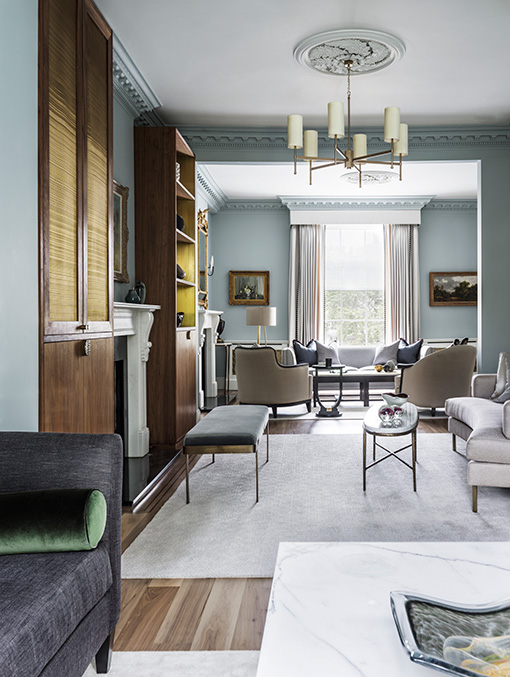
Opulent entertaining was the main focus of our clients’ requirements for this grand reception room. They wanted a pronounced hierarchy because they entertain frequently and love the grandeur of the flow from this formal space to their more relaxed entertainment areas. With an emphasis on timeless elegance, we selected delicate furnishings set against a gentle palette of blues and creams. The aim was to create a harmonious, uncluttered feel through the use of gentle curves, opulent textures and exquisitely balanced proportions.
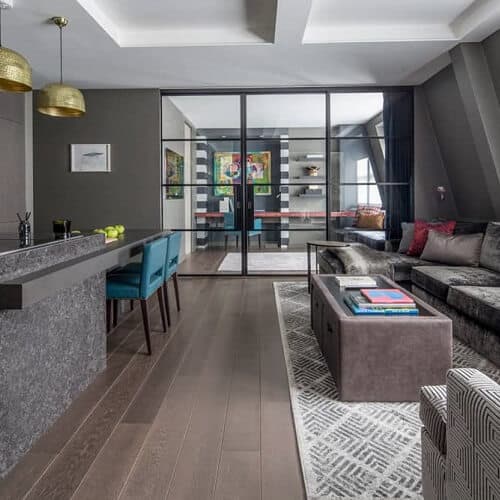
We are inspired by a diversity of styles and have produced an array of luxurious interior architecture and interior design projects. Whatever the project, whatever the brief, we analyse the requirements, assess the scope of works, and deliver a successful and distinctive result on every occasion.
A long, rectangular room can often present spatial challenges for furniture arrangement and flow. Without creating clear zones, both seating and conversation can become tricky, so the best solution here was to create three distinct seating areas.
Following our clients’ brief, we zoned the sitting room to allow for guests to be received in the front section, drinks to be served in the middle, and then we created a visual focal point at the rear with the addition of full height French doors and a Juliet balcony. Creating a visual feature as a means to draw guests through the space worked perfectly here. One’s eye is drawn to the end of the sitting room which is flooded with light and enjoys beautiful views of the garden.
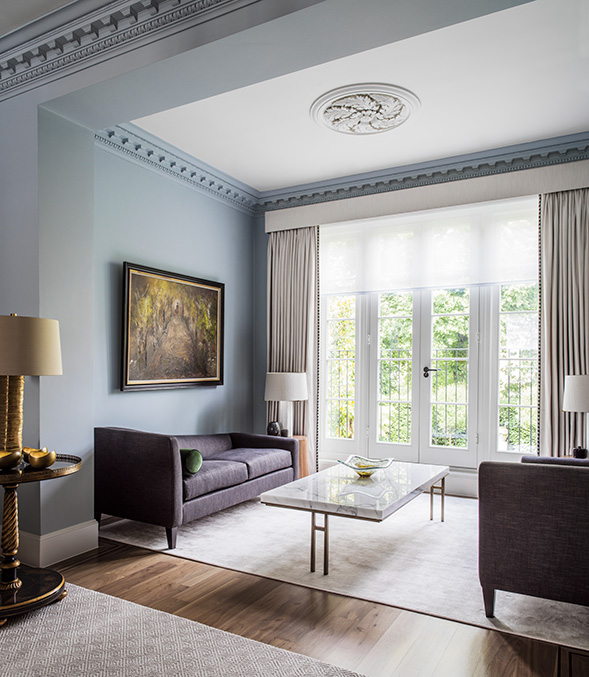
The original architectural features in this room – cornicing, ceiling roses and fireplaces – are all absolutely stunning so we felt they should be celebrated. Whenever we’re creating a classic-contemporary interior, we believe it’s always best to enhance the period features and then offset the contemporary furnishings against them.
In order to emphasise the impressive ceiling heights and to create a real feature of the architectural details, we used Little Greene‘s ‘Bone China Blue’ on all the walls of this grand space, taking it right up to include the cornicing. Also, to complement the proportions of the room, we heightened the doors to ensure a stunning aspect from the front entrance door right through to the French doors at the rear.
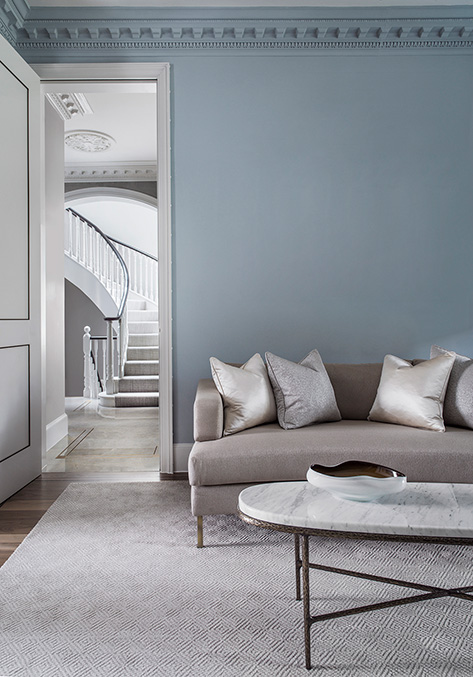
Lighting played a key role in our design for this space and really helped define the three, separate zones. As a formal entertaining room, it was important to have various light levels to complement the various functions. We used table and wall lamps in the front section of the sitting room because this is a more transient area. Then in the central section, the bespoke bar was back lit and we used joinery lighting for the shelves to provide a warm glow against the antique brass cladding. In the rear section, we specified a combination of recessed spotlights and table lamps to create appropriate levels of light.
To enhance the sense of opulent elegance in this scheme, it was crucial to ensure that any textures we introduced were as subtle and refined as possible. We opted for textured fabric in neutral shades to maintain the sense of opulence and to allow the tranquility of the pale, blue walls to dominate. Woods were chosen for their warmth and gentle graining, and classic metallic finishes such as antique brass, bronze and blackened steel were selected to enhance the sense of timelessness.
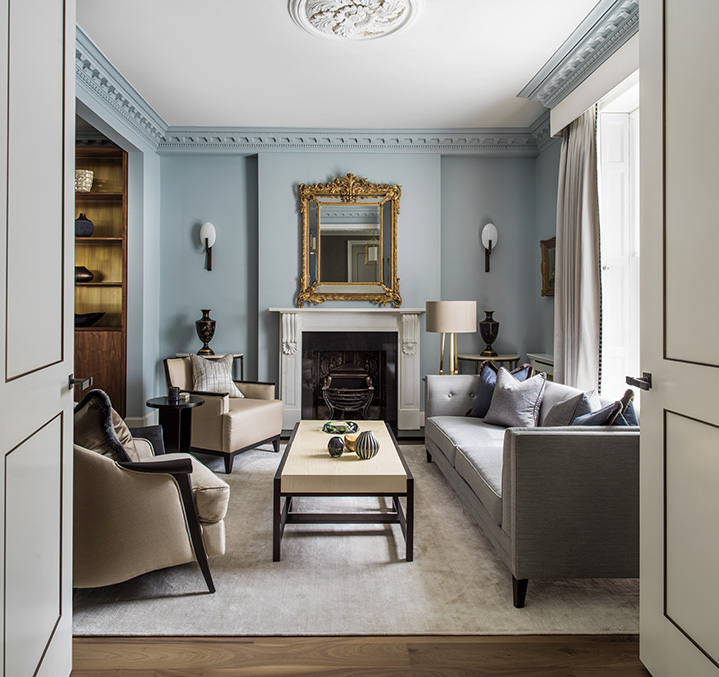
When deciding how to zone your space, you need to make function your priority. Will the area be used for socialising? If so, the placement of comfortable seating can help create your zone. Do people need to pass easily through the space? In that case you’ll want to achieve an uncluttered feel to allow for ease of movement.
Lighting can be an excellent tool for defining different parts of a room. You can illuminate a reading corner, for example, or use table lamps to define a seating area. You can also use large rugs as clear indicators of different sections within a room. Play with colour and texture to define your zones.
When you’re creating zones, it’s still important for the room as a whole to have a cohesive feel. You can do this by using the same colour throughout the zones, as we did with our Carlton Hill sitting room, or by creating links via texture, pattern or tone.
Photography by Mel Yates
The Magic of Multifunctionality Whether in London or another bustling city, urban living offers a vibrant and dynamic experience. Yet, amidst the allure, it often comes with a familiar challenge – Limited space. However, small square footage should never mean sacrificing style or functionality. Through the power of inventive interior architecture, even the cosiest homes...
When space is limited, making the most of every inch is essential. Smart design can transform rooms into multifunctional spaces, doubling their purpose and enhancing functionality. However, without careful planning, these spaces risk feeling cluttered and undefined—falling short of their true potential. At Roselind Wilson Design, we see every space as an opportunity to create...
We use cookies to ensure that we give you the best experience on our website. See our Cookie Policy. If you continue to use our website, we will assume that you are happy with it. OK

